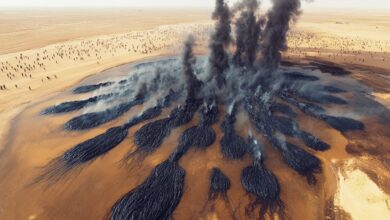41 Months On Mars: Ancient Life Found?
NASA’s Perseverance rover is exploring the Bright Angel region of Mars, which was once home to an ancient river billions of years ago. This video highlights some of the highlights from the mission:

1. **Mysterious traces on rocks**
– Perseverance found fresh traces on the surface of rocks that were not made by its wheels. This raises the question of whether something else has moved through the area.
### 2. **The “Shava Falls” rock and a possible sign of life**
– The Shava Falls rock is notable for its small “leopard spots,” about 1 mm in size, that resemble chemical stains found on Earth.
– These spots may have formed through a chemical reaction with hematite, the mineral that gives Mars its characteristic red color. On Earth, similar reactions have fueled microorganisms.
– Green Olivine crystals, which are often formed from magma, were also found, suggesting past volcanic activity.
– White veins of calcium sulfate in the rock, similar to the mineral veins formed by water flows on Earth, indicate the presence of water in the past.
### 3. **Rock and Geological Analysis**
– Perseverance used the Watson instrument to take close-up images and lasers to examine the chemical composition. These images showed clear veins of Olivine minerals and crystals, helping scientists learn more about the geological history of the area.
– The rover detected complex parallel lines in the rock, providing clues about past geological processes.

### 4. **Rock Sampling Plan**
– The NASA team decided to take samples from Shava Falls, focusing on the area containing the “leopard spots” to preserve the maximum scientific value.
– The rover is grinding the surface to prepare for core drilling, and checking the grinding tool to ensure it is not severely damaged from previous use.
### 5. **Exploring Around**
– Perseverance takes panoramic images of the area, including large dunes in ancient riverbeds, boulders crushed by the rover’s movement, and potential signs of water history.
– A rock has a prominent “white spot” that is suspected to contain silica – a mineral associated with the presence of water.
### 6. **Scientific significance**
– The combination of olivine, calcium sulfate and “leopard spots” creates a chemical environment that could have supported microbial life. The reaction of olivine with water could produce hydrogen – an energy source for microorganisms.
– The findings at Bright Angel open up the prospect of finding traces of ancient life on Mars.
### 7. **Next Steps**
– Perseverance will drill core samples at Shava Falls and continue to explore the surrounding area, including areas at the edge of the crater and the ancient river, for further evidence of water and biological activity.
**Conclusion:** Perseverance’s findings at Bright Angel are a major milestone in the search for signs of ancient life on Mars. NASA continues to mine the rover’s data to draw larger scientific conclusions.








